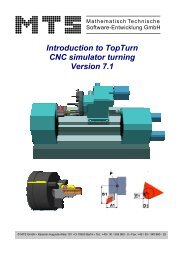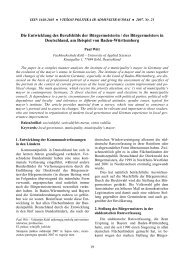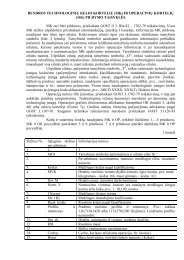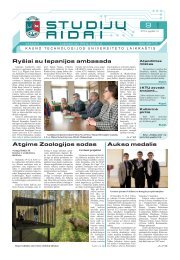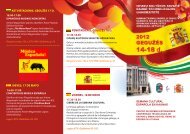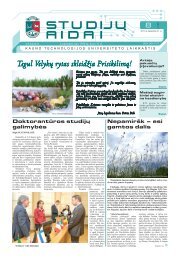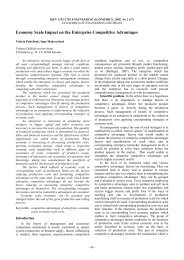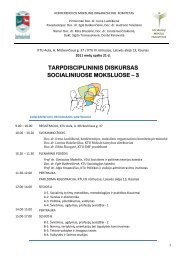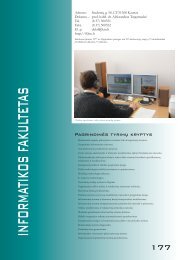cement based foam concrete reinforced by carbon nanotubes
cement based foam concrete reinforced by carbon nanotubes
cement based foam concrete reinforced by carbon nanotubes
Create successful ePaper yourself
Turn your PDF publications into a flip-book with our unique Google optimized e-Paper software.
ISSN 1392–1320 MATERIALS SCIENCE (MEDŽIAGOTYRA). Vol. 12, No. 2. 2006<br />
Cement Based Foam Concrete Reinforced <strong>by</strong> Carbon Nanotubes<br />
Grigorij YAKOVLEV 1 , Jadvyga KERIENĖ 2 , Albinas GAILIUS 2∗ , Ingrida GIRNIENĖ 3<br />
1 Izhevsk State Technical University, Studencheskaya str. 7, Izhervsk,426069, Russia<br />
2 Vilnius Gediminas Technical University, Saulėtekio 11, LT-10223, Vilnius, Lithuania<br />
3 Vilnius College of Construction and Design, Antakalnio str. 54, LT-10303, Vilnius, Lithuania<br />
Received 08 June 2005; accepted 05 January 2006<br />
The main task of the presented research was to investigate the <strong>carbon</strong> <strong>nanotubes</strong>, synthesized from aromatic<br />
hydro<strong>carbon</strong>s and as well as to investigate the possibilities of production and main technological properties of Portland<br />
<strong>cement</strong> <strong>based</strong> <strong>foam</strong> <strong>concrete</strong> <strong>reinforced</strong> <strong>by</strong> dispersed <strong>carbon</strong> <strong>nanotubes</strong>. The method of stimulation of dehydropolycondensation<br />
and <strong>carbon</strong>ization of aromatic hydro<strong>carbon</strong>s in chemical active environment (melts of aluminium, copper,<br />
nickel, iron salts) was used for <strong>carbon</strong> <strong>nanotubes</strong> synthesis. The results of investigation of the synthesized <strong>carbon</strong><br />
<strong>nanotubes</strong> <strong>by</strong> X-ray photoelectron spectroscopy showed that they contain (80 – 90) % of <strong>carbon</strong>. The examination of the<br />
<strong>carbon</strong> <strong>nanotubes</strong> microstructure <strong>by</strong> electron microscope have shown that the <strong>nanotubes</strong> have a cylindric form, with<br />
diameter ranging up to 100 nm and length up to 20 μm. The <strong>nanotubes</strong> are agglomerated to fiber shaped agglomerates<br />
with a diameter up to 30 μm and a length up to 10 mm. The <strong>carbon</strong> <strong>nanotubes</strong> were used as a high strength dispersed<br />
reinfor<strong>cement</strong> for production of <strong>foam</strong> non-autoclave <strong>concrete</strong> produced on the base of Portland <strong>cement</strong>. The results of<br />
the investigation of the <strong>reinforced</strong> non-autoclave <strong>cement</strong>e <strong>foam</strong> <strong>concrete</strong> showed that the use of <strong>carbon</strong> <strong>nanotubes</strong><br />
(0.05 % <strong>by</strong> mass) in production of these <strong>concrete</strong>s allows to decrease its heat conductivity up to (12 – 20) % and increase<br />
its compressive strength up to 70 %.<br />
Keywords: <strong>carbon</strong> <strong>nanotubes</strong>, fibrillar structures, dehydropolycondensation, <strong>carbon</strong>ization, X-ray photoelectron spectra.<br />
1. INTRODUCTION ∗<br />
In order to increase the strength of the products<br />
without changing their density, the strength of the <strong>foam</strong><br />
<strong>cement</strong> <strong>concrete</strong> matrix should be increased. This may be<br />
achieved <strong>by</strong> increasing the amount of binding materials as<br />
well as <strong>by</strong> decreasing the amount of mineral additives and<br />
<strong>by</strong> reinforcing the <strong>concrete</strong> matrix [1 – 3].<br />
The fibres, possessing a length of 5 mm to 20 mm can<br />
be added to non-autoclave <strong>cement</strong> <strong>foam</strong> <strong>concrete</strong>s and be<br />
homogenously dispersed throughout the whole <strong>foam</strong> <strong>concrete</strong><br />
volume, but they can pierce the pores structure and<br />
have no effect on the condition of the pore’s walls.<br />
That is why the highly dispersed reinforcing polymer<br />
fibres allow for only an insignificant increase in the mechanical<br />
properties of articles prepared from non-autoclave<br />
<strong>concrete</strong>. An improvement in physico-mechanical properties<br />
of non-autoclave <strong>foam</strong> <strong>concrete</strong> after hardening is<br />
possible only when the wall pores are <strong>reinforced</strong>. Taking<br />
into account the wall thickness, effective reinfor<strong>cement</strong><br />
can be achieved only <strong>by</strong> nanotube <strong>foam</strong> materials, the so<br />
called <strong>carbon</strong> <strong>nanotubes</strong>, the dimensions of which are of a<br />
power less that the wall pore diameter.<br />
Two materials exsist in nature which comply to these<br />
requirements and can be used as dispersing reinfor<strong>cement</strong>s,<br />
i.e.: halloysite Al4[Si4O10](OH)8·4H2O and chrysotile<br />
Mg6[Si4O10](OH)8·4H2O. Both have a tubular structure<br />
and nanoscale diameters (Fig. 1, a).<br />
The structure of these two materials is made up of a<br />
two layer packet of the kaolinite type, where between the<br />
two layers, a hexagonal layer of water molecules is<br />
situated.<br />
∗ Corresponding author. Tel.: +370-616-00170; fax.: +370-5-2698740.<br />
E-mail address: albinasgailius@yahoo.com (A. Gailius)<br />
147<br />
Here a difference in transition distances exists between<br />
the upper and lower plates which limits it and due to that it<br />
can bulge (Fig. 1, b). It was noted in [4], that halloysite<br />
contains Cu, Cr, Ni.<br />
a b<br />
Fig. 1. A scheme illustrating the tubular form of halloysite [4]:<br />
a – tubular form; b – tube cutting<br />
The mineral chrysotile – asbestos is used during dispersion<br />
reinfor<strong>cement</strong> of <strong>cement</strong> systems. Here, a latent<br />
danger exists to human health during production of asbestos<br />
– <strong>cement</strong> articles, also during maintenance of buildings<br />
and constructions connected with the use of asbestos<br />
materials. Due to these drawbacks, chrysotile – asbestos<br />
needs to be replaced <strong>by</strong> other dispersive reinfor<strong>cement</strong>s<br />
with similar properties which are safe to use. On the basis<br />
of the mentioned above it may be supposed that synthetic<br />
<strong>carbon</strong> nano formations posses the nearest characteristics<br />
to chrysotile – asbestos.<br />
One of the possible forms of metastable <strong>carbon</strong> nanoforms<br />
could be the quasitubular structure, i.e.: a long<br />
cylinder form package of atomic “ribbons” cut from a<br />
graphitic network (Fig. 2).<br />
One of the main elements of such a structure is the<br />
graphite layer – the surface layed out between two proper
hexagonals of <strong>carbon</strong> atoms situated at the top. The<br />
graphite layer can form an extension in the form of a full<br />
cylinder [5].<br />
Me Me<br />
а<br />
Me Me<br />
Fig. 2. A possible synthesis scheme for <strong>carbon</strong> <strong>nanotubes</strong> from<br />
eutectic melts of aromatic hydro<strong>carbon</strong>s undergoing<br />
dehydropolycondensation and <strong>carbon</strong>ization reactions<br />
The length of the <strong>nanotubes</strong> can reach tens of microns<br />
and up to several times surpass its diameter, which<br />
generally is only a few nanometers. Inverstigations have<br />
shown [6 – 9], that most of the <strong>nanotubes</strong> are made up of<br />
several graphite layers situated one above the other and<br />
wounded about one common axis. The distance between<br />
the layers practically is about 0.34 nm, which corresponds<br />
to the distance between the layers in crystalline graphite.<br />
The ability of functional groups along the axis of the<br />
<strong>nanotubes</strong> [10] to orientate and further on intensivly<br />
combine into a crystallohydrate state allowed us to obtain a<br />
compositional structure with ultradispersive reinfor<strong>cement</strong>s.<br />
The introduction of nano dispersive structures into<br />
hardening <strong>cement</strong> composition of the tubular type allowed<br />
us to create a dispersive reinfor<strong>cement</strong> in the compositional<br />
material and stimulate growths in it. Here, we waited<br />
for the formation of linear fiberous structure new-growths.<br />
These formations are possible along the surface of the<br />
<strong>nanotubes</strong> as were found in [11]. That is why, these <strong>carbon</strong><br />
<strong>nanotubes</strong> can be used as ultra dispensive reinfor<strong>cement</strong>s<br />
in non-autoclave <strong>foam</strong> <strong>concrete</strong>s.<br />
2. CARBON NANOTUBE SYNTHESIS STIMU-<br />
LATED BY DEHYDROPOLYCONDEN-<br />
SATION AND CARBONIZATION<br />
REACTIONS<br />
At present, the total volume of nanotube production in<br />
the world is calculated to be about several kilograms and is<br />
being influenced <strong>by</strong> the extraordinary high prices (several<br />
tens of dollars per gram). The question of practical use in<br />
such a situation can be solved <strong>by</strong> the development of<br />
appropriate large-scale methods for production of<br />
<strong>nanotubes</strong> at relatively low prices.<br />
It was proposed to synthesize <strong>nanotubes</strong> from condensed<br />
hydro<strong>carbon</strong> raw materials (aromatic hydro<strong>carbon</strong>s<br />
or polymers) <strong>by</strong> using the low-energy <strong>carbon</strong>ization in gelmatrix<br />
method to lower the energy needs and create a<br />
larger possibility of obtaining various tubulenes. We used<br />
b<br />
148<br />
anthracene and phenylanthracene as the starting material.<br />
Melts of aluminium, copper, cobalt, manganese, chromium<br />
chlorides as well as its mixtures of chlorides and ultradispersive<br />
powders of the corresponding metals were used<br />
also.<br />
Anthracene, phenylanthracene or its mixture was<br />
added to the melt in the form of a finely dispersed powder<br />
with a molar ratio of 1 : 5 to 1 : 10. The mixture was then<br />
heated in a flask over a sand bath with intensive mixing.<br />
Depending on the reaction composition the temperature<br />
was varied from 400 K to 570 K, the reaction time was<br />
from 2.5 to 10 hours. The process was held finished when<br />
the reaction mixture color changed to black. Then the<br />
reaction mixture was washed with acids (hydrochloric and<br />
nitric acid) to isolate the product and separate the salts. The<br />
precipitate was washed with water for several times up to a<br />
pH = 7 and dried in oven at T = 373 K. Then it was treated<br />
with organic solvents, like benzene, chlorobenzene, acetone<br />
to remove the unreacted hydro<strong>carbon</strong>s and other low-<br />
molecular compounds of the reaction. To eliminate the<br />
possibility of sticking, the obtained product was dispersed<br />
in alcohol or acetone and with the help of ultrasonic field<br />
(80 kHz, 20 V) created <strong>by</strong> a piezoelement type CTS-19<br />
(dimensions 0.67×8×20 mm 2 ). The obtained black color<br />
material after treatment was resistant to acids and alkali<br />
and withstood temperatures up to (900 – 1000) °C in the<br />
air.<br />
A technology was developed for low-temperature<br />
<strong>carbon</strong> nanotube synthesis [12] and patented in 2001<br />
(Russian patent № 2169699).<br />
3. INVESTIGATION OF SYNTHESIZED<br />
NANOTUBES<br />
We used X-ray photoelectron spectroscopy (XPS) to<br />
investigate the synthesized <strong>nanotubes</strong>. Specimens for investigations<br />
<strong>by</strong> XPS were deposited on indium substrates.<br />
Spectra were recorded on a X-ray photoelectron magnetic<br />
spectrometer (AlKα emissions) and X-ray electron<br />
spectrometer ES-2401 (MgKα emissions) in a vacuum of<br />
10 –5 Pa.<br />
The XPS spectra of specimens obtained from a<br />
mixture of anthracene and phenylanthracene in a media of<br />
ultra dispersed powered of copper monochloride and<br />
copper are given in Fig. 3, while in Fig. 4 – in the same<br />
media but only polyphosphoric acid was added.<br />
According to the presented spectra, relatively intensive<br />
peaks were observed for <strong>carbon</strong> and oxygen in Fig. 3 and<br />
for <strong>carbon</strong>, oxygen and phosphorus in Fig. 4. It was<br />
determined according to the obtained spectra that there<br />
were approximately 15 % oxidized groups present in the<br />
product, where <strong>carbon</strong>yl (286.5 eV) and <strong>carbon</strong>ate<br />
(288 eV) dominate.<br />
Apparently the treatment of the reaction mixture with<br />
nitric acid causes partial oxidation of the <strong>carbon</strong> – metal<br />
containing system.<br />
The XPS spectra were used to determine the dehydropolycondensation<br />
– <strong>carbon</strong>ization product composition and<br />
its relationship to the purification conditions: <strong>carbon</strong><br />
(80 – 84) %, oxygen (11 – 16) %, chlorine (1.5 – 5.5) %,<br />
copper (0 – 2.3) %, phosphorus (0 – 1) %, nitrogen<br />
(0 – 1) % (in atomic percentage).
Binding energy, eV<br />
Fig. 3. XPS spectra (C1s, O1s) of <strong>carbon</strong> – metal containing<br />
specimens obtained from mixture of anthracene,<br />
phenylanthracene and copper monochloride with<br />
microdispersed copper<br />
According to the data obtained from XPS investigation<br />
we can say that the product of stimulated dehydropolycondensation<br />
– <strong>carbon</strong>ization of aromatic hydro<strong>carbon</strong>s<br />
contained (80 – 90) % of <strong>carbon</strong>, depending on the method<br />
used for purification.<br />
The scanning electron microscope investigation<br />
showed that the obtained material is composed of fibre<br />
shaped agglomerations (length up to 10 mm) with a complex<br />
inner structure containing nanostructures of a<br />
cylindrical shape.<br />
In Fig. 5, a, scanning electron microphotograph is<br />
given of a specimen obtained as a result of dehydropolycondensation<br />
in a mixture of anthracene and phenylanthracene<br />
in a media of ultra-dispersed powder of copper<br />
and its chloride. This sample contains cylindrical fibre<br />
shaped particles with a diameter of 1 micron to 30 microns<br />
(Fig. 5, a) which are composed of nanostructures of the<br />
same form (Fig. 5, b) with diameters up to 100 nm and<br />
length up to 20 μm (Fig. 5c).<br />
Investigations into the main reaction mechanisms of<br />
stimulated <strong>carbon</strong>ization of aromatic hydro<strong>carbon</strong>s in the<br />
system > allow<br />
Binding energy, eV<br />
230 μm<br />
30 μm<br />
a b c<br />
100 nm<br />
Fig. 5. Microstructure of <strong>carbon</strong> – metal containing new –<br />
growths obtained from aromatic hydro<strong>carbon</strong>s <strong>by</strong> the<br />
stimulated dehydropolycondensation and <strong>carbon</strong>ization<br />
method: a – general view; b – a fragment of cleaved fibre<br />
shaped formation ; c – <strong>carbon</strong> <strong>nanotubes</strong><br />
us to say that the formation of crystalline <strong>carbon</strong> samples<br />
in these systems occurs at low temperatures. During the<br />
<strong>carbon</strong>ization process, the <strong>carbon</strong> transforms into<br />
nanoparticles encapsulating the initial reagents and/or its<br />
conversion products and covering them with a few orderly<br />
layers of graphite.<br />
4. NANODISPERSIVE REINFORCEMENT OF<br />
FOAM CONCRETES<br />
The developed <strong>carbon</strong> <strong>nanotubes</strong> were used as a highstrength<br />
nanodispersive reinfor<strong>cement</strong> in compositional<br />
crystallohydrated materials to improve the physicomechanical<br />
properties of non-autoclave <strong>cement</strong> <strong>foam</strong><br />
<strong>concrete</strong>s. The admixture used was a product with a<br />
density of 0.086 g/cm 3 , containing <strong>carbon</strong> <strong>nanotubes</strong> with<br />
a diameter of (40 – 60) nm and filled with copper.<br />
Traditional technology methods with technical <strong>foam</strong> were<br />
used to prepare the <strong>cement</strong> <strong>foam</strong> <strong>concrete</strong>. The admixture<br />
wetted poorly, so the surface was treated with a surfactant<br />
<strong>based</strong> on a solution of lignosulfonate salt.<br />
The choice of the composition to be used for <strong>foam</strong><br />
<strong>concrete</strong> mixture preparation was made <strong>based</strong> on the<br />
desired grade of <strong>foam</strong> <strong>concrete</strong> up to a density of<br />
350 kg/m 3 . The amount of reinfor<strong>cement</strong> phase in the<br />
mixture was 0.05 % <strong>based</strong> on the initial mass. The<br />
Fig. 4. XPS spectrum (C1s, O1s, P2p) of <strong>carbon</strong> – metal containing specimens obtained from a mixture of anthracene and<br />
phenylanthracene, polyphosphoric acid and ultradispersed copper<br />
149
Table 1. Physico-mechanical characteristics of <strong>cement</strong> <strong>foam</strong> <strong>concrete</strong><br />
№<br />
Amount of <strong>nanotubes</strong>,<br />
% <strong>based</strong> on the<br />
composition mass<br />
Average<br />
density,<br />
kg/m 3<br />
Compressive<br />
strength,<br />
MPa<br />
Heat conductivity<br />
coefficient, λ,<br />
W/mK<br />
Pore<br />
diameter,<br />
μm<br />
Condition of<br />
wall pores<br />
1 0 330 0.18 0.07 40 – 600 perforated<br />
2 0.05 309 0.306 0.056 60 – 150 homogeneous<br />
a b c d<br />
Fig. 6. Cement <strong>foam</strong> <strong>concrete</strong> structure: a – without <strong>nanotubes</strong>, b – with 0.05 % <strong>nanotubes</strong>; pore walls; c – without <strong>nanotubes</strong><br />
(perforated), d – stabilised with addition of 0.05 % of <strong>nanotubes</strong><br />
physico-mechanical properties of the prepared specimens<br />
(100×100×100) mm were determined <strong>by</strong> the standard<br />
methods and the results are given in Table 1.<br />
As we can see from Table 1, the modification of<br />
<strong>cement</strong> <strong>foam</strong> <strong>concrete</strong>s <strong>by</strong> the addition of <strong>carbon</strong><br />
<strong>nanotubes</strong> allowed us to decrease in average density from<br />
330 kg/m 3 to 309 kg/m 3 and at the same time to increase<br />
the compressive strength <strong>by</strong> 70 % (from 0.18 MPa to 0.306<br />
MPa). The modification allowed to lower the heat<br />
conductivity <strong>by</strong> 20 % (from 0.07 W/m K to 0.056 W/m K).<br />
The comperative analysis of the compressive strength<br />
values of <strong>cement</strong> <strong>foam</strong> <strong>concrete</strong>s with densities up to<br />
350 kg/m 3 and the compressive strength values of<br />
500 kg/m 3 density <strong>cement</strong> <strong>foam</strong> <strong>concrete</strong>, not <strong>reinforced</strong><br />
and <strong>reinforced</strong> <strong>by</strong> <strong>carbon</strong> <strong>nanotubes</strong>, showed that the<br />
modification <strong>by</strong> <strong>carbon</strong> <strong>nanotubes</strong> allows to increase the<br />
compressive strength of <strong>cement</strong> <strong>foam</strong> <strong>concrete</strong> approximately<br />
<strong>by</strong> the same percent, inspite of its density value.<br />
The compressive strength value of 500 kg/m 3 density not<br />
<strong>reinforced</strong> <strong>cement</strong> <strong>foam</strong> <strong>concrete</strong> <strong>by</strong> <strong>carbon</strong> <strong>nanotubes</strong> is<br />
0.87 MPa, compressive strength value of the same density<br />
<strong>cement</strong> <strong>foam</strong> <strong>concrete</strong> <strong>reinforced</strong> <strong>by</strong> <strong>carbon</strong> <strong>nanotubes</strong> is<br />
1.45 MPa (increased <strong>by</strong> 65 %).<br />
The distribution of <strong>nanotubes</strong> throughout the <strong>cement</strong><br />
<strong>foam</strong> <strong>concrete</strong> plays the role of centers for directive<br />
crystallization, which on one part brings about the<br />
development of a fibrillar structure on the pore walls,<br />
which in turn ensures its continuity and uniformity<br />
(Fig. 6, d), while on the other hand ensures an orderly<br />
structure orientated supermolecular sheath about the<br />
nanotube. This causes an increase in <strong>cement</strong> <strong>foam</strong> <strong>concrete</strong><br />
strength and lowering of heat conductivity in the <strong>cement</strong><br />
<strong>foam</strong> <strong>concrete</strong> article.<br />
The microstructure investigation results have shown,<br />
that the presence of <strong>carbon</strong> <strong>nanotubes</strong> in the <strong>foam</strong> <strong>cement</strong><br />
<strong>concrete</strong> stabilizes its structure (Fig. 6, d) and ensures the<br />
150<br />
absence of pore wall percolation indications, which occur<br />
generally in common <strong>foam</strong> <strong>concrete</strong>s (Fig. 6, c).<br />
Generally the presence of not <strong>reinforced</strong> <strong>foam</strong> <strong>concrete</strong><br />
pores with perforated walls causes a decrease in its<br />
strength and in all, a decrease in mechanical properties of<br />
the investigated material as well as in its heat conductivity.<br />
A better pore size uniformity (Fig. 6, b) was observed<br />
in <strong>foam</strong> <strong>concrete</strong>s containing an admixture of <strong>carbon</strong><br />
<strong>nanotubes</strong>, while in <strong>concrete</strong>s without <strong>carbon</strong> <strong>nanotubes</strong>,<br />
due to intensive percolation of wall pores (Fig. 6, a) causes<br />
them to combine into lager ones, which in turn increases<br />
the heat conductivity of the <strong>foam</strong> <strong>concrete</strong> and deteriorates<br />
its maintenance characteristics. The stabilization in <strong>foam</strong><br />
<strong>concrete</strong> structures is mainly due to the reinfor<strong>cement</strong><br />
effect of the addition of fibrillar structures and ordering<br />
effect due to the formation of a supermolecular structure in<br />
the <strong>cement</strong> pore walls.<br />
In that way we ensured the development of effective<br />
<strong>foam</strong> <strong>concrete</strong>s with modified pore walls which was a<br />
result of reinfor<strong>cement</strong> with <strong>carbon</strong> <strong>nanotubes</strong>.<br />
CONCLUSIONS<br />
1. The results of the investigation of the <strong>carbon</strong><br />
<strong>nanotubes</strong> synthesized using the method of stimulation of<br />
dehydropolycondensation and <strong>carbon</strong>ization of aromatic<br />
hydro<strong>carbon</strong>s in chemical active environment (melts of<br />
aluminium, copper, nickel, iron salts), carried out <strong>by</strong> using<br />
X-ray photoelectron spectroscopy and electron microscopy,<br />
showed that the <strong>carbon</strong> <strong>nanotubes</strong> obtained <strong>by</strong> this<br />
way contain (80 – 90) % of <strong>carbon</strong>, they have the cylindric<br />
form, their diameter is ranging up to 100 nm and length up<br />
to 20 μm. The <strong>nanotubes</strong> are agglomerated to fiber shaped<br />
agglomerates with a diameter up to 30 μm and length up to<br />
10 mm.<br />
2. The use of <strong>carbon</strong> <strong>nanotubes</strong> (0.05 % <strong>by</strong> mass) as<br />
the reinfor<strong>cement</strong> for production of <strong>foam</strong> non-autoclave
<strong>concrete</strong>, produced on the basis of Portland <strong>cement</strong>, allows<br />
to decrease its heat conductivity up to (12 – 20) % and to<br />
increase its compressive strength up to 70 %.<br />
REFERENCES<br />
1. Kahmer, H. Fibrous Concrete Successfully Used in<br />
Structural Precast Component Production Concrete Plant +<br />
Precast Technology 67 (8) 2001: pp. 26 – 31.<br />
2. Tagnit-Hamou, A., Vanhove, Y., Petrov, N. Microstructural<br />
Analysis of the Bond Mechanism Between Polyolefin<br />
Fibers and Cement Pastes Cement and Concrete Research<br />
ISSN 0008-8846 35 (2) 2005: pp. 364 – 370.<br />
3. Girnienė, I., Laukaitis, A. The Effect of the Hardening<br />
Conditions on Foam Cement Concrete Strength and Phase<br />
Composition of New Formations Materials Science<br />
(Medžiagotyra) ISSN 1392-1320 8 (1) 2002: pp. 77 – 82.<br />
4. Penkalia, T. V. Articles of Crystallochemistry. Ed. Frank –<br />
Kamenskij. Leningrad: Chemistry, 1974: 496 p. (in Russian).<br />
5. Dresselhaus, M. S., Dresselhaus, G., Eklund, P. C.<br />
Science of Fullerenes and Carbon Nanotubes. Academic<br />
Press, 1997: 1216 p.<br />
6. Kodolov, V. I., Shabanova, I. N., Makarova, L. G.,<br />
Khokhriakov, N. V., Kuznecov, A. P., Nikolaeva, O. A.,<br />
Keriene, J., Yakovlev, G. I. Research of Structure of<br />
Products of the Stimulated Carbonization of Aromatic<br />
151<br />
Hydro<strong>carbon</strong>s Journal of Structural Chemistry 42 (2)<br />
2001: pp. 260 – 264 (in Russian).<br />
7. Ebbesen, T. W. Wetting, Filling and Decorating Carbon<br />
Nanotubes J. Phys. Chem. Solids 57 (6 – 8) 1996:<br />
pp. 951 – 955.<br />
8. Zhang, X., Cao, A., Li, Y., Xu, C., Liang, Ji, Wu, D.,<br />
Wei, B. Self-organized Arrays of Carbon Nanotube Ropes<br />
Chem. Phys. Lett. 351 2002: pp. 183 – 188.<br />
9. Kurt, R., Bonard, J. M., Karimi, A. Structure and Field<br />
Emission Properties of Decorated C/N Nanotubes Tuned <strong>by</strong><br />
Diameter Variations Thin Solid Films 398 – 399 2001:<br />
pp. 193 – 198.<br />
10. Yakovlev, G. I. Structural Organization of Interphase<br />
Layers at Creation of Crystallohydrated Composite<br />
Materials Thesis on Completion of a Scientific Degree of<br />
the Doctor of Engineering Science Perm, 2004: 35 p.<br />
(in Russian).<br />
11. Seeger, T., Redlich, Ph., Grobert, N., Terrones, M.,<br />
Walton, D. R. M., Kroto, H. W., Ruble, M. SiO-coating of<br />
Carbon Nanotubes at Room Temperature Chem. Phys. Lett.<br />
339 2001: pp. 41 – 46.<br />
12. Babuchkina, S. N., Kodolov, V. I., Kuznecov, A. P.,<br />
Nikolaeva, O. A., Yakovlev, G. I. Way of Obtaining<br />
Carbon-Metals Containing Nanostructures. Patent of Russia<br />
Federation 2169699, B.J. 2001, № 18 (in Rusian).



